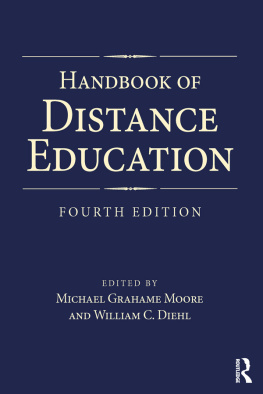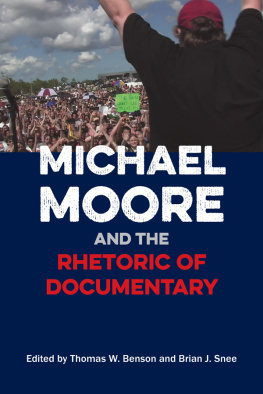Michael Grahame Moore - Handbook of Distance Education
Here you can read online Michael Grahame Moore - Handbook of Distance Education full text of the book (entire story) in english for free. Download pdf and epub, get meaning, cover and reviews about this ebook. year: 2019, publisher: Routledge, genre: Politics. Description of the work, (preface) as well as reviews are available. Best literature library LitArk.com created for fans of good reading and offers a wide selection of genres:
Romance novel
Science fiction
Adventure
Detective
Science
History
Home and family
Prose
Art
Politics
Computer
Non-fiction
Religion
Business
Children
Humor
Choose a favorite category and find really read worthwhile books. Enjoy immersion in the world of imagination, feel the emotions of the characters or learn something new for yourself, make an fascinating discovery.
- Book:Handbook of Distance Education
- Author:
- Publisher:Routledge
- Genre:
- Year:2019
- Rating:4 / 5
- Favourites:Add to favourites
- Your mark:
- 80
- 1
- 2
- 3
- 4
- 5
Handbook of Distance Education: summary, description and annotation
We offer to read an annotation, description, summary or preface (depends on what the author of the book "Handbook of Distance Education" wrote himself). If you haven't found the necessary information about the book — write in the comments, we will try to find it.
Handbook of Distance Education — read online for free the complete book (whole text) full work
Below is the text of the book, divided by pages. System saving the place of the last page read, allows you to conveniently read the book "Handbook of Distance Education" online for free, without having to search again every time where you left off. Put a bookmark, and you can go to the page where you finished reading at any time.
Font size:
Interval:
Bookmark:

The Handbook of Distance Education, 4th Edition is a comprehensive compendium of research in the field of distance education. Chapters framed in terms of empirical research explore how technology can facilitate more effective teaching and learning experiences, and the books inclusion of specific digital tools is thoroughly current. The volume is divided into four sections covering the historical and theoretical foundations of distance education, attributes of teaching and learning using technology, management and administration, and different audiences and providers. Throughout, leading scholars address future research needs and directions based on current research, established practices, and recent changes to implementation, pedagogy, and policy across contexts.
Michael Grahame Moore is Distinguished Professor Emeritus of Education at The Pennsylvania State University, USA, and founder and editor of The American Journal of Distance Education, the first journal in its field. He published the first statement of theory about distance education in 1972 and has contributed to many other firsts in laying the foundations of the field.
William C. Diehl is Coordinator of Online Graduate Programs in Lifelong Learning and Adult Education and Assistant Professor of Education at The Pennsylvania State University, USA. He is associate editor of The American Journal of Distance Education and co-director of The American Center for the Study of Distance Education.
Fourth Edition
Edited by Michael Grahame Moore and William C. Diehl

First published 2019
by Routledge
52 Vanderbilt Avenue, New York, NY 10017
and by Routledge
2 Park Square, Milton Park, Abingdon, Oxon, OX14 4RN
Routledge is an imprint of the Taylor & Francis Group, an informa business
2019 Taylor & Francis
The right of Michael Grahame Moore and William C. Diehl to be identified as the authors of the editorial material, and of the authors for their individual chapters, has been asserted in accordance with sections 77 and 78 of the Copyright, Designs and Patents Act 1988.
All rights reserved. No part of this book may be reprinted or reproduced or utilised in any form or by any electronic, mechanical, or other means, now known or hereafter invented, including photocopying and recording, or in any information storage or retrieval system, without permission in writing from the publishers.
Trademark notice: Product or corporate names may be trademarks or registered trademarks, and are used only for identification and explanation without intent to infringe.
First edition published 2003 by Lawrence Erlbaum Associates, Inc.
Third edition published 2013 by Routledge
Library of Congress Cataloging-in-Publication Data
Names: Moore, Michael G., editor.
Title: Handbook of distance education / edited by Michael Grahame Moore and William C. Diehl.
Description: Fourth edition. | New York : Routledge, 2019. | Previous edition: 2013. | Includes bibliographical references and index.
Identifiers: LCCN 2018036230 (print) | LCCN 2018051762 (ebook) | ISBN 9781315296135 (eBook) | ISBN 9781138238992 (Hardback) | ISBN 9781138239005 (Paperback)
Subjects: LCSH: Distance educationHandbooks, manuals, etc.
Classification: LCC LC5800 (ebook) | LCC LC5800 .H36 2019 (print) | DDC 371.35dc23
LC record available at https://lccn.loc.gov/2018036230
ISBN: 978-1-138-23899-2 (hbk)
ISBN: 978-1-138-23900-5 (pbk)
ISBN: 978-1-315-29613-5 (ebk)
Typeset in Bembo
by Apex CoVantage, LLC
Michael Grahame Moore
Part 1
Historical and Theoretical Foundations: An Overview
William C. Diehl
Linda M. Black
William C. Diehl and Leslie Cano
Michael Grahame Moore
Jon Dron
Martha Cleveland-Innes, D. Randy Garrison, and Norman Vaughan
Edith Gnanadass and Amelia Y. Sanders
Robert M. Bernard, Eugene Borokhovski, and Rana M. Tamim
Part 2
Teaching and Learning: An Overview
William C. Diehl
Richard E. West, Janette R. Hill, and Liyan Song
Mike Allen, Kikuko Omori, Andrew W. Cole, and Nancy Burrell
Tina M. Stavredes and Tiffany M. Herder
Maggie Hartnett
Elaine Fabbro and Jennifer Rempel
Charles R. Graham
Melody M. Thompson
Zane L. Berge
Elizabeth Childs and Susan Crichton
Priya Sharma, Kimberly Tohill, Philip Tietjen, and Mahir Akgun
Vanessa P. Dennen
Rick L. Shearer and Eunsung Park
Rebecca Heiser and Penny Ralston-Berg
Shelley Kinash, James Birt, and Madelaine-Marie Judd
Linda Barril
Part 3
Management, Policy, and Administration: An Overview
William C. Diehl
Michael F. Beaudoin
Ray Schroeder and Vickie S. Cook
Van L. Davis
Sheila Jagannathan
Julie Porosky Hamlin and Lori Williams
Tomas A. Lipinski and Martin J. Brennan
Patrick R. Lowenthal and Gayle V. Davidson-Shivers
Kay Shattuck
Part 4
Audiences and Providers: An Overview
William C. Diehl
Shanna Smith Jaggars
Scott Gibbons, Matthew Yauk, and Kay K. Seo
Peggy L. Kenyon and Timothy Flora
Dietmar Kennepohl
Shari L. Jorissen
Saul Carliner
Michael K. Barbour
Beatriz Fainholc
Tian Belawati and Melinda dela Pea Bandalaria
This newly revised edition of the Handbook, like its predecessors, is about research and other scholarship in distance education. The book follows a similar thematic structure to previous editions, with the exception being the combining of the section dealing with teaching and the one dealing with learning. Thus the book is presented in four Parts, as follows:
- Historical and Theoretical Foundations
- Teaching and Learning
- Management, Policy, and Administration
- Audiences and Providers
This structure is only slightly modified from that of previous editions, and its purpose remains the sameto provide access to a broad selection of the scholarly and research literature, organized in a way that will enable students and practitioners to identify sources relevant to their particular needs, as the first step leading to their personal, in-depth, follow-up literature research. It was the perceived need for such a compilation that led to the publication of the first edition of the Handbook in 2003, at a time when it had become apparent that distance education had already emerged to be one of the most significant developments in education of the previous quarter century.
The need for a new and updated edition is no less acute, six years from the last edition, as distance education continues to make inroads into the mainstream of educational and training practice at all levels, and in virtually every field of learning. Across this wide educational spectrum, it remains the subject of close attention by policy makers and administrators as well as teachers and students. Its traditional role of opening opportunities for learners and its more recent role of adding to the quality of teaching are roles now widely recognized, as much by professors in universities and community colleges as by trainers in corporations and the armed forces, in continuing professional education of teachers, physicians and nurses, public accountants and pharmacists, leaders of voluntary organizations, managers in the corporate boardroom and workers seeking new skills on the factory floor. What I described in the first edition as the recent frenzy of precipitant innovation driven by excitement about Internet technology, has subsided to a considerable extent, as those who got caught up in that early excitement have discovered for themselves the challenges as well as the benefits offered by the technology. Online communication has long ceased to be an innovation for most teachers, as they have settled down to confront the more interesting work involved in acquiring the skills needed for designing and delivering quality programs and understanding their students beyond the classroom. Less cautiously than before, an increasing number of the leaders of their institutions have also faced the challenge of developing the different management and administrative changes needed to accomplish good quality distance teaching. Most difficult among these are changing the allocation of resources required to produce mediated programs with quality, and the particularly difficult job of channeling their faculty into roles more appropriate for the information age than those they have been accustomed to performing in the classroom. Even so, in this regard, timidity still overshadows boldness and considerable more education of the leaders is called for. Of course it is the students who are learning new ways and set the pace for both their teachers and administratorsa generation having grown up to be at ease with social networking and mobile technologies, accustomed to learning informally out-of-school, and inducted from an early age into the satisfaction of independent learning online.
Font size:
Interval:
Bookmark:
Similar books «Handbook of Distance Education»
Look at similar books to Handbook of Distance Education. We have selected literature similar in name and meaning in the hope of providing readers with more options to find new, interesting, not yet read works.
Discussion, reviews of the book Handbook of Distance Education and just readers' own opinions. Leave your comments, write what you think about the work, its meaning or the main characters. Specify what exactly you liked and what you didn't like, and why you think so.









